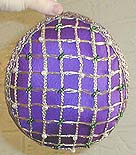

Medieval examples |
Medieval examples |
Modern |
Modern |
A
long time ago in a galaxy far, far away |
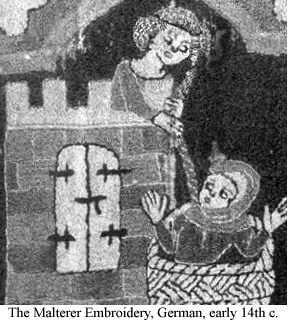 |
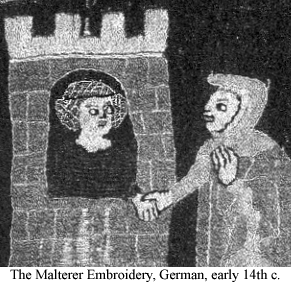 |
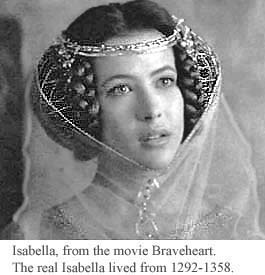 |
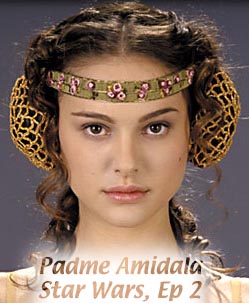 |
|
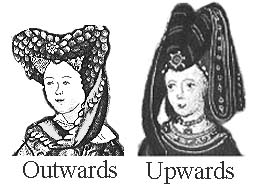 1430 and 1440 I believe these are a self-contained structure that you can take on and off, not nets over hair. |
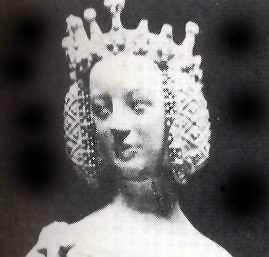 Jean of Bourbon, died 1390, but I think it may be later than that date. |
 This one is a single piece
construction, but gives a similar look. Details
of construction for this one are on another page. This one is a single piece
construction, but gives a similar look. Details
of construction for this one are on another page. |
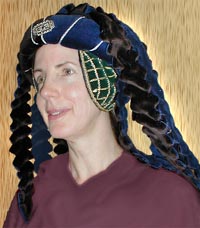 Pamelina poses for us in these cauls, and a stuffed-roll hat with turned dags. |
I
don't think there's any doubt that the costume designer was thinking
about the medieval cauls, eh? |
Norris's Medieval Costume and Fashion, reprinted in 1999 by Dover, was originally published in 1927 as Costume & Fashion, Volume II: Senlac to Bosworth 1066-1485. Due to the printing technology of the time, redrawings were often the best way to present pictures, but this sort of interpretation of the old works tends to introduce errors. Norris's sources for the cauls are listed as:
Queen, from the time of Edward II (figure
300, p. 215): The figures of "weepers" on the tomb of John of Eltham
represented kings and queens, relatives of the deceased. It is
not
certain which is Margaret of France, second queen of Edward I, but all
the queens are robed in costumes such as this lady and her niece,
Isabella of France, Queen of Edward II, would wear. Figure 300 is
a drawing constructed from some of these "weepers." [...] The headdress
is that described under figure 263, surmounted by the royal diadem."
(263 is a lady with braided buns at the temples, with a wimple, veil,
and circlet.)
Until I can find pictures of these weepers, my conclusion, based
upon being able to find no reliable medieval images of just the earmuff
cauls, or cauls with wimple and veil, is that Norris is mistaken, or,
possibly, that we costumers have mistaken Norris. He actually
doesn't say that the cauls were only over the ears, but his pictures
look like it. He does mention the whole-head caul.
That said, maybe you want to make some anyway. Most of this
article was written several years before the above search for proof.
Carry on!
Let's put our cards on the table: this is *not* the authentic way to
make these things, even if they were a documentable style -- but this
version *does* give a very good appearance at a few feet away. This is
not to say that everyone agrees how they (the medieval folks) did make
them; could have been something like this; could have been entirely of
wire (I doubt it, myself; see me if you're curious why not) could have
been trained gold-colored snakes.
You can read my info on the Arnolfini hat to find out more, or read how to make a reticulated headdress, which is a related style. The cylinder caul/crespinette must certainly be related, and it, at least, can be documented, although apparently somewhat different proportions.
So, with that dispensed with, let's get to work. This is a
good project for one evening while watching TV. All of this is
hand sewing, but it's easy.
Now, apply the gold netting. If it is ribbon-style, apply the first strip along the center of the form, and tack it down by sewing. Lay the next strip so that it appears to be a continuation of the structure of the first one. Baste that down. Use this process until the whole cap is covered. Tack the edges of the netting down about 1/4 inch from the edge of the cap, so the ends don't frizz up when you trim them to the edge of the cap, just like you did with the under-fabric.
Now take the ribbon, and fold it over the edge of the form, so that it covers the raw edges of the net and the under fabric, as well as bending around the perimeter and going inside the form a bit. You may want to pin it down, or not. Sew this down neatly.
Lastly, use the remaing ribbon to make a span of ribbon between the two points of the juliet cap. This will make it easy to keep on your head, but they will look like earmuffs, and your friends will tease you. However, if they didn't do this, their cauls will be forever moving around, and you can laugh at them later. Be sure the band is long enough -- on a largeish head there will be about 3" between the points. Sew this down. I am experimenting with a thin tie from the bottom of the caul that goes under the chin to stabilize them when worn under wimples.
You can add pearls, beads, and other trim as you like.
Wear it under a stuffed roll (also very easy) or other similar
headgear.
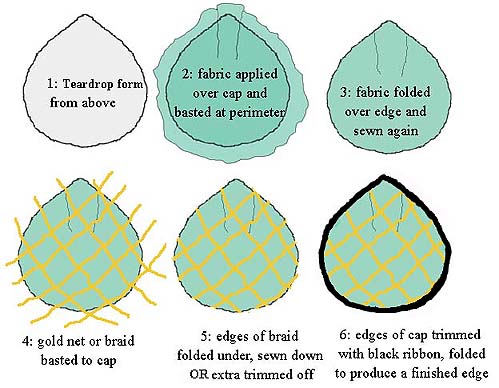
| All material © 1999 & 2003 Cynthia Virtue, except of
course the movie photos |
Email Author with comments |
| Back to Virtue Ventures Main Page | Back to Article Index |